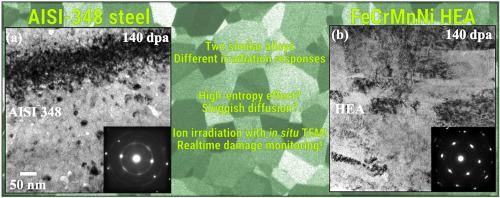Intermetallics ( IF 4.3 ) Pub Date : 2021-02-17 , DOI: 10.1016/j.intermet.2021.107130 M.A. Tunes , G. Greaves , H. Bei , P.D. Edmondson , Y. Zhang , S.E. Donnelly , C.G. Schön

|
Two metallic alloys in the quaternary system Fe–Cr–Mn–Ni were irradiated in situ within a transmission electron microscope (TEM) using Xe+ heavy ions in the temperature range of 293–873 K and in the regime of low- (30 keV) and medium-energies (300 keV) with respective maximum doses of around 40 and 140 dpa. The first alloy is the FeCrMnNi high-entropy alloy (HEA) synthesised with the alloying elements close to equimolar composition. The second alloy is a commercial austenitic stainless steel AISI-348 (70.5Fe-17.5Cr-1.8Mn-9.5Ni wt.%), selected as the “low-entropy” counterpart of the FeCrMnNi HEA. Microstructural characterisation was carried out in the TEM with in situ heavy ion irradiation to investigate the role of entropy on radiation induced segregation and precipitation (RIS and RIP). The results demonstrated that among all the irradiation cases investigated, the FeCrMnNi HEA had its random solid solution matrix phase preserved in 80% of the experiments whilst the austenite matrix of the AISI-348 steel underwent RIP in 80% of the cases. It is therefore demonstrated that small differences between two alloys can lead to different radiation responses, confirming the trend that, by tuning the elemental composition superior radiation resistance can be achieved in metallic alloy systems, but emphasising that some of the constitutive core-effects of HEAs are still in need of further confirmation especially when the application of HEAs in energetic particle irradiation environments is considered.
中文翻译:

奥氏体不锈钢与高熵合金对应物的比较辐照响应
使用Xe +重离子在293-873 K温度范围内和低(30 keV )态下,在透射电子显微镜(TEM)中原位辐照四元体系Fe–Cr–Mn–Ni中的两种金属合金。)和中等能量(300 keV),最大剂量分别约为40和140 dpa。第一种合金是FeCrMnNi高熵合金(HEA),其合金元素接近等摩尔组成。第二种合金是商业奥氏体不锈钢AISI-348(70.5Fe-17.5Cr-1.8Mn-9.5Ni wt。%),被选作FeCrMnNi HEA的“低熵”对应物。显微组织表征是在TEM中原位进行的重离子辐射,以研究熵在辐射诱导的分离和沉淀(RIS和RIP)中的作用。结果表明,在所研究的所有照射案例中,FeCrMnNi HEA在80%的实验中均保留了其随机固溶体基质相,而AISI-348钢的奥氏体基质在80%的情况下进行了RIP。因此,证明了两种合金之间的微小差异会导致不同的辐射响应,从而证实了通过调整元素组成可以在金属合金系统中获得优异的抗辐射性的趋势,但强调了HEA的一些本构核心效应仍然需要进一步确认,尤其是考虑到HEA在高能粒子辐照环境中的应用时。











































 京公网安备 11010802027423号
京公网安备 11010802027423号